Introduction
The rise of the digital giants — Google, Apple, Facebook and Amazon — has heralded a complete change in customer expectations from service providers, both off-line and online. Amazon’s one-click purchase and same-day delivery and Apple’s focus on flawless design have established a high standard. This extends beyond the smartphones to customer experiences overall, as customers today expect flawless experiences across channels, everywhere and at all times.
In this shape-shifting market, digital natives battle incumbents to the bottom on prices. All incumbent firms should have a similar high dose of technology in their DNA, giving them the strategic power and know-how against new-age enterprises that are taking market share. Enterprises must look to revamp the complete customer digital experience as a first step in this direction.
And time is precious.
IDC, a global market intelligence firm, predicts that by 2020, 30% of the world’s largest public companies will have made significant inroads into digital transformation, allocating 10% of total revenue to their top digital strategies1.
Those that don’t do the same will suffer financially, and in a disruptive nonlinear landscape, laggards will find it harder and harder to catch up to those that do take up these initiatives early.
Customer experience, though, is not something that can be solved by just bolting on better apps and services to existing user journeys and business processes. Rather, it is built from the inside out; highly influential experiences occur when the “core” of an organization is fit and performing. Hence, organizations with legacy core systems must modernize them and then progress outward to build experiences at the periphery.
That said, creating a beautiful customer experience requires more than just implementing the latest digital technologies.
A large amount of creativity, data science, design thinking and collaborative business culture are just some of the building blocks underlying each memorable customer experience.
Within this dynamic, a large number of organizations continue to be unaware of the depth and dimensions of a solid customer experience. Is a good multichannel experience crucial? What about increased engagement across devices through better-quality service and operational efficiency? Since customer experience is tightly correlated with enhanced digital marketing capabilities, what is the organizational inclination for data analytics, cloud and DevOps ways of working? And for those incumbents looking to partner with a service provider to improve their customer experience, how important are industry expertise, cultural performance and digital experience platforms?
Given these strategic questions, Infosys conducted research to determine how organizations are tackling the problem of customer experience, and what issues and solutions are currently on their radar. As part of this research, in March 2019 Infosys commissioned a survey by an independent market research firm. The firm spoke with 160 leaders from companies with revenues exceeding US$1 billion; across industries including manufacturing, financial services and high tech; and residing in several leading industrial regions: Australia, Canada, Europe, New Zealand and the United States.
The survey addressed digital transformation objectives and their relationship to customer experience; the need to transform and modernize core enterprise systems to provide customers with a multichannel experience as well as to bring about large-scale digital transformation; and investments across technologies that optimize digital marketing capabilities (which, in turn, deliver more fluid, seamless customer journeys).
The survey also looked at preferred approaches to improve the customer experience through commercial off-the-shelf technology, internal capabilities or external solution providers. Finally, since transformation is rarely something that firms do alone, we asked these leaders to share the critical capabilities they seek in a partner. The major survey findings are discussed in this report.
Executive summary
- Organizations recognize the importance of enterprise systems to provide customers a multichannel experience (55% said “important” or “very important”).
- Customer experience improvement is the biggest value derived from omnichannel engagement (14%), followed by convenience through multichannel sales (9%).
- Data analytics, followed by cloud, attract the greatest investments to optimize digital marketing capabilities.
- Seventy-one percent of these organizations seek the services of external solution providers in varying degrees to improve customer experience, while just 10% prefer to go it alone.
- When looking for a partner, leaders place the greatest importance on expertise in emerging or digital technologies. Capabilities in digital experience platforms and industry or domain-specific expertise were a close second and third when looking for an external provider.
Customer experience needs core modernization
Customer experience can be simply defined as the “product of an interaction between a customer and an organization over the duration of their relationship” 2. For example, the complete automotive customer experience or customer journey includes everything from the company’s advertising and communications at the awareness stage to the dealer’s selling process, delivery management and after-sales services.
As products increasingly become commoditized, experience quality becomes a differentiator for competing brands. Firms must position themselves to deliver products and services better, faster and cheaper while never losing sight of the customer sentiment that drives market forces. Innovation, collaboration with partners and business culture transformation all work to support this aim.
This agile operating model and the experience that it provides are used by digital upstarts to take market share from long-standing market leaders. To survive the challenge, incumbent organizations must also offer a frictionless, memorable experience, with agility established into their own DNA so that they can compete as customer expectations increase. Unfortunately, legacy core systems stand in the way for far too many large enterprises.
Without a modern digital core, it is nearly impossible to produce great customer experiences.
Imagine a favorite ride-sharing app. It offers precious little on its own. The experience comes together only when there’s an efficient integration of cars and drivers at the edge, powered by a robust core system such as enterprise resource planning. Organizations must refresh their core when they consider renewing their customer experience capabilities.
In a related research report on digital acceleration, 64% of the respondents (160 similar executives) stressed the importance of core modernization in digital transformation (a further 21% said that modernizing the core was “somewhat important”). In the same study, the respondents stated that “profitability through operational efficiency” and an “enhanced customer experience” are the main value drivers of their core modernization. In the present study, the respondents were also asked about the importance of core systems to provide customers with a multichannel experience across devices. More than 50% said that it was either “important” or “very important.” It is reasonable to infer from this data that most organizations talk of core modernization and customer experience creation in the same breath, as part of the overall conversation around digital transformation.
The importance of core modernization and customer experience is reinforced further in Figure 1. The top two digital transformation priorities for respondent companies are outcomes of core modernization: 73% look to increase efficiencies while 70% seek innovation in products or services. Additionally, 69% of respondents seek to build enhanced customer experiences.
Figure 1. Digital transformation priorities in the short to mid term: efficiencies, product innovation and customer experience
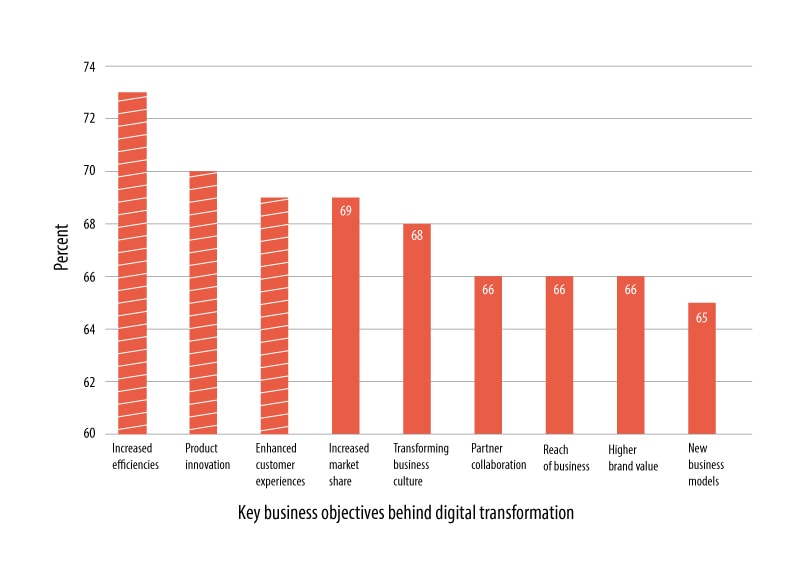
Convert customers through omnichannel engagement
The explosion in the number of touch points is a highly visible aspect of the digital revolution. Customer engagement cannot be limited to a specific channel. Customers expect a seamless omnichannel experience, with contextual information retained at all times. Customers interact across channels, using different devices to engage with providers. These organizations are able to capitalize on this relationship by improving the experiences on the products and services they offer. In the survey, respondents named “improved customer experience” as the biggest source of value realized from omnichannel engagement (14%) while 53% of respondents chose not to comment. The vice president of a large manufacturing firm in the United States said there was value in a “multichannel approach to sales that provides customers with a seamless shopping experience, whether they shop online from a desktop or mobile device, by telephone, or in a brick-and-mortar store.”
Omnichannel is a distinct step forward from disparate multichannel experiences, bringing together channels such as smart TVs, smartphones, wearable gadgets, smart kiosks and social media to give customers a more convenient journey, on their terms, whether online or off-line. If customers are dissatisfied with an offering across channels, negative sentiments on social media can erode brand image significantly.
Delivering a true omnichannel experience ensures that a business is available to customers in their preferred manner, whenever and wherever they want.
This type of experience is more likely to convert a prospect unaware of the brand into a brand advocate. However, for this to be a dependable capability, business processes must be integrated across channels.
This customer-centric solution differentiates companies such as Apple, Intel and Nvidia from the rest of the competition, and keeps them at the top of Drucker Institute’s ranking of the most effective companies in the world 3. And because these giants have raised consumer expectations significantly, incumbent organizations can remain competitive by offering relevant services to customers when, where and how they want them.
For memorable omnichannel customer experiences, traditional data analysis must be complemented with context that helps companies understand customer motivation and desires. In addition to seamless processing of transactions across devices and channels, firms can gain actionable insights about their customers through “thick data.”
Thick data provides on-the-ground intelligence about why customers use different services and channels, and for what reason.
While all companies can gain from this important addition to big data analytics, those in consumer-driven industries — telecom, services, retail — especially need to get this right to remain relevant in rapidly evolving markets.
A new customer experience dimension has emerged: “conversation.” With improvements in natural language processing and generation technologies, conversation — voice or text-based chat, with chatbots and virtual assistants — is now an important channel of experience delivery. Automation, which encompasses this aspect of the digital experience, was considered a high priority investment by 25% of the leaders.
Following customer experience, the biggest source of value realized from omnichannel engagement is the convenience of multichannel sales, which was mentioned by 9% of the respondents. Increased loyalty, better service quality, wider presence, operational efficiency and higher sales each came in at 4% as a source of value.
Case study
Omnichannel experience for a leading chain of beauty stores in the US
Infosys delivered an omnichannel commerce experience with a “buy anywhere, fulfill anywhere and return anywhere” function for a leading chain of beauty superstores in the U.S.
The solution included an m-commerce app and a responsive website for the e-commerce site, a feature enabling customers to create and share photo collections with their social circle, a multithreaded order-processing system to optimize fulfilment, and core system integration along with a new loyalty management system.
Benefits to the client included a 42% increase in traffic from mobile devices and 53% sales growth year on year through a loyalty initiative on Cyber Mondays.
Invest in data for exemplary customer experience
The most famous examples of positive digital experiences we know today include shopping on Amazon, navigating on Google Maps and binge-watching on Netflix. What do they have in common? They are each built on exemplary use of data.
Data enables differentiation in customer experience. When used correctly, data enables the creation of experiences that are meaningful to their target audiences. Also, data-driven insights help incumbent organizations take on their digital challengers by matching or even exceeding their customer experience.
Organizations invest enormous amounts in data, overcoming many of the false signals of historical marketing to develop a customer picture that is at once detailed and monetizable. Netflix, the most valuable media company in the world (as of April 2019), has been highly successful in identifying what customers really want to watch. It collects data from 139 million subscribers, which it then analyzes to recommend shows to users using predictive analytics. Over 75% of viewer activity on Netflix is based on personalized recommendations 4.
These predictive analytics capabilities are a crucial factor in C-suite decisions for customer experience transformation.
Asked to rate the level of digital marketing technology investment, 46% of the survey participants said their organizations had high investments in data analytics (from a list offering the options of high, medium or low). Other technologies receiving substantial investments were cloud (38%), internet of things (30%) and digital experience platforms (28%). IT investments were higher than business investments across all modernization efforts, pointing to a greater awareness that IT has in these emerging technologies.
Building IoT ecosystems is one way to improve customer experience. Digital experience platforms, such as those offered by Adobe, IBM and Salesforce, are another. These platforms are centrally deployed to continually improve digital experiences and allow businesses to share content, data, logic and other elements across digital touch points. These platforms also build on web experience management channels, which have the ability to collect user behavior and provide unique content to the target audience. The difference is that they define the journey after customer acquisition, with the goal to grow customer satisfaction and loyalty.
Case study
Unified view across channels with real-time analytics at a US-based clothing retailer
Cross-channel transactions at many apparel retailers are growing in relevance. People first browse in store, before taking their shopping online. Outfits might then be returned at a nearby store. By treating online and off-line channels as separate entities, the core of the supply chain at most retailers cannot leverage potential opportunities, which has the knock-on effect of inferior customer engagement and user experiences.
The challenge for a major U.S. clothing retailer was to find a way to create a holistic view of transactions across all channels so that they could optimize both their supply chain and the customer experience.
Infosys helped build a data lake that presented the retailer with a 360-degree view of all channels in “near real time.” This data model allowed customer promotions across online and in-store entities to be executed in sync. The data lake also offered better visibility into orders placed, orders canceled and orders shipped, thus leading to better demand forecasting and a pain-free experience for customers.
Not only did customer experience improve at the retailer, but by optimizing the supply chain, it also saved millions of dollars. Time to insights for sales projection was slashed from between two and three days to minutes with latency reductions up to 600 fold.

Leaders want to choose the right partner
Many disciplines inform the creation of customer experience — creative thinking, user empathy, usage behavior, experience design, and of course, the different technologies and expertise involved in application development. But how do organizations go about procuring such diverse skills?
The largest cohort of respondents — 37% — said they used a combination of in-house capabilities, commercial off-the-shelf solutions and external service providers to improve customer experience. U.S. (47%) and Canadian (45%) companies favor this approach the most. Nineteen percent of the survey respondents preferred a combination of in-house and external capabilities. In all, there was a clear preference to involve external service providers, with 71% of the respondents preferring external service providers either separately or in combination.
That said, the challenges of choosing the right partner can be formidable. Approaching the right technology partnership requires careful thought and planning along all stages. It starts with a clear understanding of the gap between customer expectations and a firm’s in-house capabilities. From there, a company must identify how people, processes and technology can close that gap. This requires collaboration between technology experts and business users.
Figure 2. Majority of companies surveyed prefer to work with an external partner to optimize customer experience, with AI heading the list
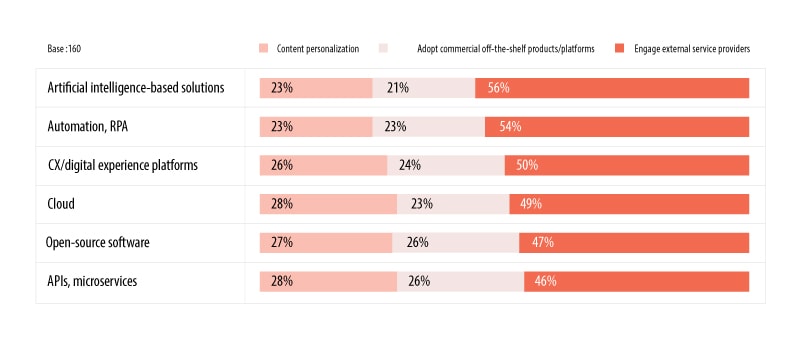
In this survey, with every technology analyzed (Figure 2), the respondents showed a consistent preference for using external service providers, followed by personalizing content on all channels to discover customer requirements.
The need for an external provider was strongest in the case of artificial intelligence-based solutions (56%)
And at least half of the respondents wished to work with an external provider in implementations involving automation or robotic process automation (54%) and customer or digital experience platforms (50%).
Figure 3. Technology remains a priority when companies choose external service providers to transform customer experience
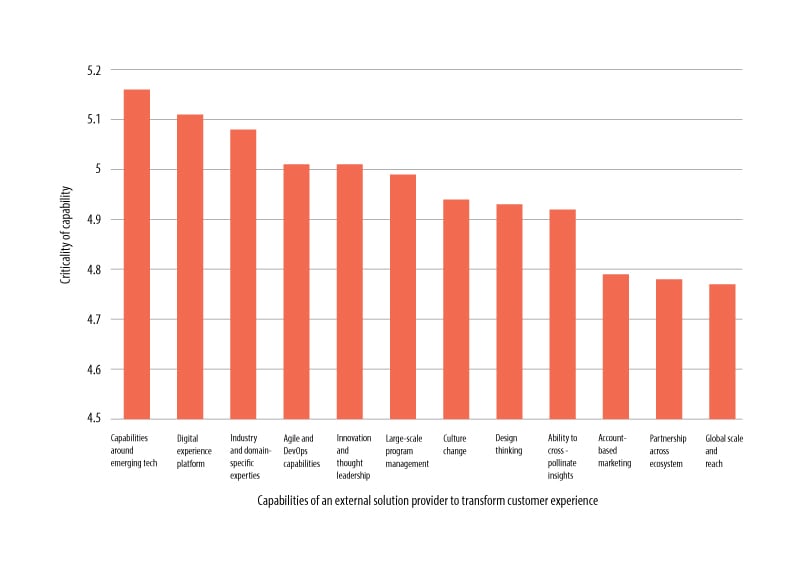
What do organizations, seeking to transform the customer experience, look for in an external service provider? Our research indicates that emerging technology is the top capability for partners to transform client experiences (Figure 3). On a scale of one (not at all critical) to seven (very critical), the respondents ranked capabilities around emerging or digital technologies at the top (5.2), followed by digital experience platforms for individualized interactions (5.1), with capabilities around industry and domain-specific expertise a close third (5.1). In the U.S., partners with expertise in emerging technologies and digital platforms scored even higher — both 5.3. As one vice president at a life sciences firm in Europe pointed out, firms are looking for more automation and technology driven by self-service.
Innovation and thought leadership was also important (5), similar to sound Agile and DevOps proficiency.
This reinforces our report finding on accelerating digital transformation through core modernization (Core Modernization as a Catalyst). In that study of 160 CXOs, partners that combine digital technology expertise with innovation and thought leadership are crucial to core modernization success.
Business leaders often view core modernization, customer experience, and their partners as mutually inclusive, related decisions.
Respondents also gave importance to creative skills like innovation and design thinking. These skills are harder to acquire, and IT solution providers need to explore a wider talent pool beyond STEM graduates to acquire them. We recommend recruiting graduates from other academic backgrounds for these roles to bring different skills and mindsets. Enterprises (or their partners) should develop design studios where both creative and logical skills are brought together to produce useful, usable experiences.
Case study
Reimagining a UAE website with Infosys, Brilliant Basics and Codescrum
Codescrum, a software solution design provider based in the U.K. partnered with Brilliant Basics — the digital innovation and customer experience studio owned by Infosys — to revamp the United Arab Emirates’ “Watani” website.
Commissioned by the UAE government as part of its digital transformation program, the Watani website was overhauled in a bid to improve graphics, colors and the customer experience. Because Arabic is read from right to left, the website had to support both left-to-right and right-to-left responsive design, along with the ability to support popular mobile phone screen resolutions both in the western world and in the Arabic countries.
Conclusion
In our research, 69% of the incumbent leaders said that elevating customer experience to match that of digital challengers was a priority in the short to medium term. However, a great experience cannot be bolted on at the organization’s periphery; rather, it evolves from within by modernizing the core with necessary digital capabilities while innovating the customer-facing edge.
The survey also suggests that organizations understand the correlation between core modernization and customer experience for digital transformation, with 55% saying that core systems were an important factor in building out a multichannel experience across devices.
In the context of digital transformation, modernizing the core is not enough.
Beautiful customer experiences can only occur through a connected set of offerings — from service design and experience at one end to a renewal of legacy technologies, processes, systems and ways of working at the other.
In time, and if done correctly, incumbent enterprises can meet rising customer expectations and deliver personalized experiences at scale — all at the speed of market.
As companies seek to amplify digital experiences, they must look beyond simply predicting customer needs to proactively addressing them through automation. Virtual assistants will offer self-service without human involvement, and conversational commerce will reach a level of maturity where voice-based services respond to a large percentage of customer queries.
In building their customer experience capability, a majority of the survey respondents (seven out of 10) were keen to partner with external service providers to some extent, either individually or in combination with in-house capabilities and commercial off-the-shelf solutions. Expertise in digital and emerging technologies as well as the availability of a digital experience platform are the most important capabilities expected from an external provider.
But there’s more to creating customer experience than technology alone. Innovation and thought leadership, internally and from service partners, are more important than ever before. IT providers must combine creative skills with technical expertise to build truly great experiences.
The companies that will win are those who transform from having a transactional relationship with customers to one based on creating experiences for ongoing engagement. Companies that rise to the occasion will elevate their customer and employee experience from ordinary to extraordinary.
Survey methodology
In March 2019, Infosys commissioned an independent market research firm to conduct an online survey that captured feedback from 160 CXOs and other senior-level respondents. The respondents represented multiple industries and hailed from Australia, Canada, Europe, New Zealand and the United States.
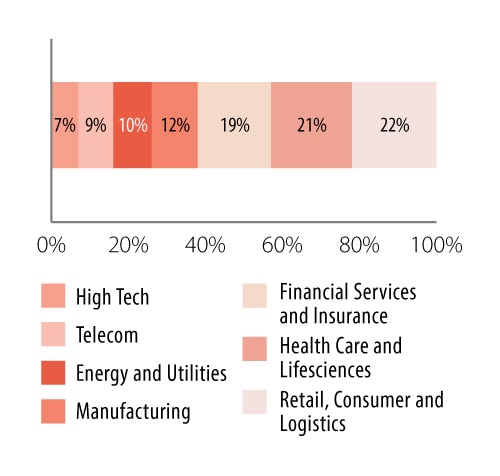
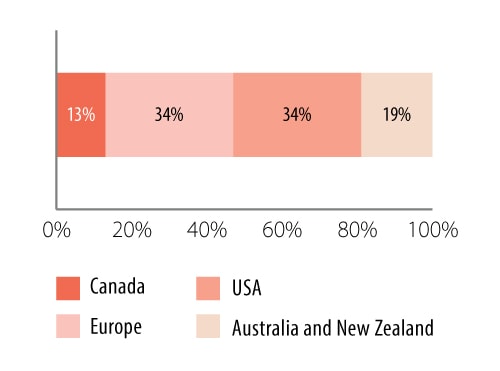
About Infosys Knowledge Institute
The Infosys Knowledge Institute helps industry leaders develop a deeper understanding of business and technology trends through compelling thought leadership. Our researchers and subject matter experts provide a fact base that aids decision making on critical business and technology issues.
To view our research, visit Infosys Knowledge Institute at infosys.com/IKI





